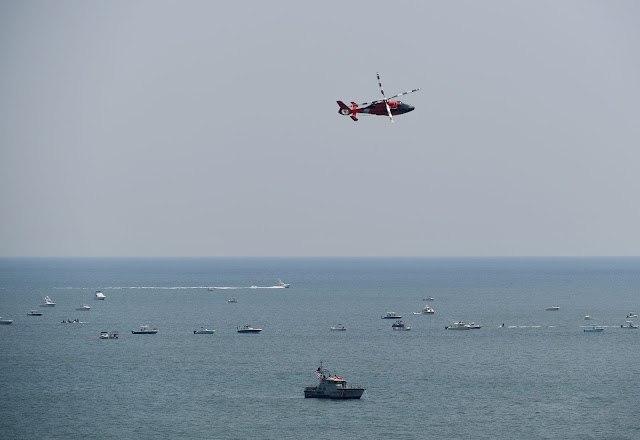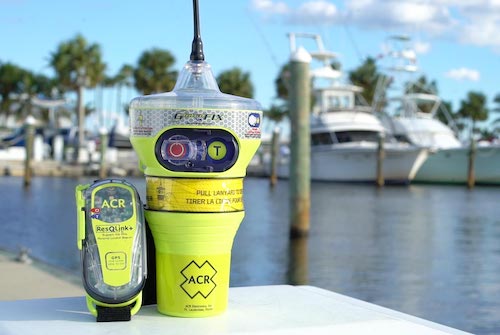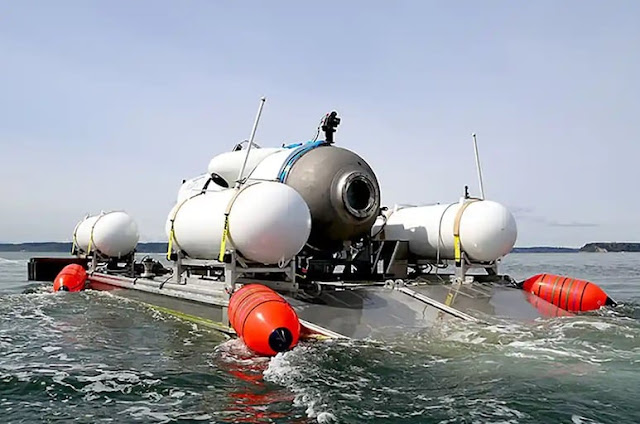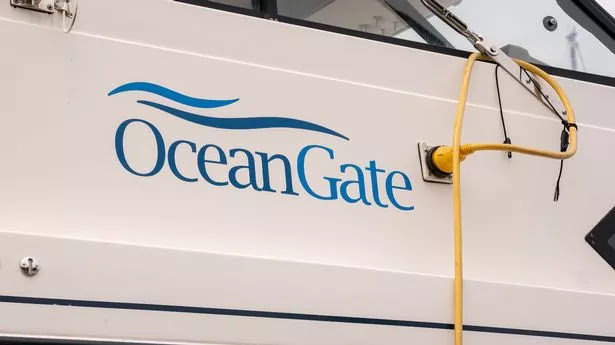 |
| Ocean Gate, Submersible Titan |
18th June, 2023
On 18th June 2023, at 9.30 am, 5
people sat in a submarine called Titan and dove into the sea. They were going to
see the wreck of the Titanic. The same historical ship Titanic sunk into the
sea about 100 years ago. This is a very expensive and extreme sort of adventure
travel. For the few hours of this journey, each person in the submarine had
paid more than 20 million yen. The Titanic's wreck is submerged deep in the
ocean, which explains why this voyage is so pricey. Specifically, 3,810 meters
beneath the water's surface.
Submersible Titan:
This Submersible Titan started its journey under the water. The 3,810-meter depth is reached in around 2 hours. At every 15-minute interval, this submarine sends a signal to the support ship on the surface of the sea, named the Polar Prince. This was their only line of contact with the outside world.
Rescue operation:
To locate this submarine, a huge
search and rescue effort is conducted. There were also robot vehicles, ships,
and aircraft. Everyone had only one question in their mind.
 |
| Rescue operation |
What happened to these passengers? "The
US Coast Guard says that the debris from the Titan has been brought to the
surface from the ocean floor."
The damage to the hull is consistent with the
loss of a pressure chamber. The same arrogance and arrogance that doomed that
ship is what doomed those people on the sub.
Submarine disappeared:
The place where this submarine
disappeared is in the Atlantic Ocean near Canada. 600 km off the coast of
Newfoundland, on a small Canadian island. Here, deep in the ocean, you’ll find
the Titanic’s broken-up wreck, with the bow and stern lying about 800 meters
apart. The Titan submarine that disappeared here was not a submarine but a
submersible.
|
Feature |
Submarine |
Submersible |
|
Definition |
A vessel that can operate underwater and travel independently between the surface and submerged depths. |
A vessel that can operate underwater. |
|
Size |
Can be much larger than submersibles. |
Typically smaller than submarines. |
|
Power |
Powered by a variety of sources, including nuclear reactors, diesel engines, or electric motors. |
Powered by batteries or fuel cells. |
|
Depth |
Can reach depths of up to 30,000 feet. |
Can reach depths of up to 10,000 feet. |
|
Purpose |
Used for military purposes, such as warfare and surveillance. |
Used for research, exploration, and tourism. |
|
Crew |
Typically crewed by a small number of people. |
Can be unscrewed or crewed by a few people. |
|
Launch and recovery |
Can launch and recover itself. |
Requires a mothership to launch and recover it. |
Difference between submarine and submersible:
These two terms have a lot in common. So, using the word submarine to simplify things, but there is a very important difference between these two words. Submarines have their own power. They can use a port to go into the sea and come out of the sea independently.
 |
| submersibles |
A ship that’s on the water, on the
surface, and is in control. In this case, the support ship is the Polar Prince.
The entire operation was managed by OceanGate. OceanGate was owned and operated
by a company named Stockton Rush.
Who is Stockton Rush?
By profession, he had been an
aerospace engineer. And in 2009, he founded the Ocean Gate company. A private
company, whose purpose was to take rich people on deep sea expeditions as
tourism.
 |
| Stockton Rush |
Let’s get into the details of how it’s going to work.It’s an exploration of the wreck. The explorers will take part in the dives to use sonar communication systems to take pictures, and collect data. It’s a very hands-on experience.
Titanic tours:
Launched in July 2021, this company began providing Titanic tours. Previously, they provided tours of other ship’s wrecks and locations. As can still be seen on their website, in addition to the Titanic, they also offered tours in the Azores and the Bahamas.Titan wasn’t the company’s only submersible
Antipodes and Cyclops:
In addition to these two vessels, Ocean Gate also owned the Antipodes submersible and the Cyclops submersible. Antipodes could go up to a depth of 304 m, and Cyclops up to 500 m.
At 2,600 feet, that’s where the giant octopus swims. Giant octopuses are so big they look like they’re from outer space.
As you descend, the midnight zone begins at an altitude of 3,800 ft. No sunlight reaches below this mark. Everything turns black after this. The water temperature here is around 4°C. 5,000 feet. If you go down for 5,000 feet 6,000 feet 8,000 feet10,000 feet11,500 feet 12,500 feet.
This is the ocean bottom, where the wreck of the Titanic rests.Pressure at this depth of the ocean is nearly 400 times that of the surface. So, whichever submersible goes to this dept.
Titan, on the other hand, was built to fall 4,000 meters. 4 km underwater. This is why this was the only submersible to go to the Titanic. To get a better idea of how deep 3,800 meters is, take a look at this chart made by The Washington Post. Measurements are in feet here. Normally, a man's height is 6 feet. The iceberg that collided with the Titanic was 100 feet above the surface of the water and several times that underwater. The deepest recreational scuba diving depth is 130 feet. After 650 feet, the twilight zone begins, where very little light penetrates the water.1, 600 feet was the depth of the deepest-ever underwater rescue operation conducted to date.
Its design should be thoroughly thought out. The
glass for exterior viewing could only be as large as this. The Titan's
viewport, also known as a "viewport," was the largest that had ever
been installed in a private sub. The Titan was not as large, seating only 5
passengers. The hull, or main body, of the Titan's sub was carbon fiber.
Two caps were attached at the end, which were made of titanium. It had a length of 6.7 meters and a weight of over 10,400 kilograms. It had four electric motors on the outside. Two horizontal and two vertical, through which it could be operated. This sub was controlled by a video game controller. This is not as weird, because the US Navy also controls their submarines and the periscopes the viewports to see outside, but yes, the entire submarine, Titan, was being controlled with a video game controller.
This
means that this video game controller was also being used by the pilot in the
submersible. There were no seats inside the sub, but there was a small toilet
located next to the viewport. However, there was no barrier around the toilet,
meaning that if someone needed to use the toilet, they would have to face the
opposite direction. To keep looking at a TV screen while the toilet was being
used. Because these submersibles go so deep into the water, the GPS doesn't
work here. They communicated with their support ship via text messaging.
18th June, 2023:
It is still unclear which internet connection
was available on the ship. In this tweet from a few back, Ocean Gate had said
that they were using Starlink's satellite internet service to communicate. If
we come back to this story of 18th June, then 5 people were on board this
submersible that day.
People in Submersible:
The first was 58-year-old British billionaire, Hamish Harding. He was also an adventurer and was a three-time holder of the Guinness World Record At one time, he did a 4-hour dive into the deepest part of the ocean, Mariana Trench Last year, he took part in the inaugural Blue Origin sub-orbital flight, launched by Jeff Bezos' space exploration company.
The second passenger was Paul Henri Nargeolet, 77 years old. A former commander, of the French Navy. 37 times he visited the wreck of the Titanic. He was the director of underwater research of the RMS Titanic.
.jpeg) |
| Shahzada Dawood and his son Suleman |
The third and fourth passengers were a British-Pakistani businessman, Shahzada Dawood and his 19-year-old son, Suleman. He was the proprietor of one of Pakistan’s largest companies. The submersible spoke to the support ship every 15 minutes that day.
This communication stopped at 11:15 AM. After this, no communication, and no signal is received. Despite this, the Titan was expected to surface again at 16:30, as planned. Why? Because if the submersible did get stuck underwater, the passengers could tilt it from the inside and move it from side to side to lift it back to the surface. To do this, the ballasts would have to be removed.
Ballasts are an essential part of large ships and submersibles. They provide stability to the vessel. They are just heavyweights. With ballasts, a boat can sink in the water.In ancient times, ballasts were made of stone and sandbags.
But today, submarines use water ballasts. Ballast tanks are filled with water so that the weight increases and the submarines sink into the water. The incident began at approximately 4:30 PM when the Titan failed to surface. Personnel in the support vessel waited for a period of time before notifying the United States Coast Guard at approximately 7:10 PM, triggering the commencement of a race against time. With only 4 days' worth of oxygen available in Titan, the rescue operation had only 4 days to locate the passengers alive.
The EPIRB is commonly installed on ships as an emergency locator, which allows the vessel to be located. However, it was not installed on Titan. Another issue was that, even if Titan were to return to the sea surface, the occupants of the submersible would perish due to a lack of oxygen, as there was no way to open the submersible from within.

Emergency Position Indicating Radio Beacon
The door of this submersible could only be locked from the outside and opened from the outside. So whether the submersible was inside the water or on the surface, those 4 days were very critical. And to top it off, the search radius was a whopping 25,000 kilometers! Imagine how difficult it is to find a van-sized submersible in such a huge area. And the deepest underwater rescue that has been done so far was only done till the depth of 480 meters underwater in 1973. But still, the rescue teams put their lives at stake.
At the outset, this operation was initiated by two aircraft from the United States and two aircraft from Canada. Sonar was deployed by them so that they could detect signals even from underwater. Three ships started the search from the surface, but as time passed, more ships started coming in for the search operation.
Remotely operated vehicles:
Some remotely operated vehicles, i.e. ROVs were also used here. They can be thought of as robot-like vehicles in which there is no operator in the vehicle, but they are able to submerge into the water and locate objects. And they are controlled from the surface of the water. Three ROVs were searching for Titan.
After 3 days of searching, on the
3rd day of the search operation, sonar from a Canadian aircraft heard some
banging noises. In half-hour intervals, some sounds were heard, like someone
knocking on the door. The United States Coast Guard also became aware of the
sounds. Subsequently, on June 22nd, a remotely operated vehicle (ROV) searching
the bottom of the ocean encountered debris approximately 490 meters away from
the bow of the Titanic. Upon inspection of the debris, it was established that
the Submersible had decomposed, resulting in the death of the occupants inside.
After searching some more, 5 pieces
of debris were found in total. The US Coast Guard said in a press conference
the same day that the banging sounds they heard were not related to the Titan
submersible.
Reason of Titan destroyed:
Actually, the main body of the Titan, it was made of carbon fiber. Submarines and submersibles typically consist of steel, titanium, or aluminium. However, Titan's carbon fibre design was an experiment. No one had previously tested the characteristics of carbon fibre in the depths of the ocean. Upon examination of this disaster, it can be concluded that carbon fibre is unsuitable for this purpose.
The man who discovered the wreck of
the Titanic:
In 1985, Robert Ballard discovered the wreck of the Titanic. He said they've gone down thousands of times in various vehicles to reach the ocean's bottom, but they've never lost a car. This is the first time a sub or submersible has gone down like this. James Cameron, who's known for his movies Titanic and Avatar has been in the deep sea lots of times for various missions. He said, "If you think about our history, being in a boat like Alvin, which I spent a lot of time in, it's way safer than driving down I-95 on a regular day." The titanium caps were still on the bottom unharmed, but the carbon fiber core was scattered all over the place. He strongly criticized Titan saying that safety regulations were not followed.
Interviews of Ocean Gate Company’s CEO:
In 2019, there was a long article published in Smithsonian Magazine where the CEO talked about Ocean Gate. He said that "the (US) Passenger Vessel Safety Act of 1993 was needlessly prioritizing passenger safety over commercial innovation." He felt that this act is useless and that there is no necessity to pay so much kindness to protection. In another interview last year, he said, "At some point, safety just is pure waste. Basically, if you want to stay safe, don't even think about getting out of bed, getting in your car, or doing anything. Then Rush says, "I broke some rules to do this, and I think I broke them with good engineering and logic. Carbon fibre and titanium are not supposed to be used, but I used them. I broke the rule, and I did it on purpose." Rush knew he was doing an experiment that could be really dangerous.
- In January 2018, Ocean Gate's Director of Marine Operations, David Lochridge, had actually mentioned safety concerns about Titan Submersible. When OceanGate ignored the warnings, he took them to court.
- He argued in court that the submersible should have been subject to a safety evaluation and certification. Ocean Gate denied it. He said the company did not want to spend money on safety.
- The legal battle in the court was eventually settled later in 2018.
- But then, on March 27th, 2018, 36 different people wrote Stockton Rush a letter. They were industry professionals, deep sea researchers, oceanographers and so on. They said that the experimental approach being taken not getting things quality checked, can lead to a terrible accident someday.
- Another deep sea exploration specialist wrote to the CEO in March 2018 to “be a little more conservative about safety.” He wrote that Rush was “putting himself and his clients at risk.” In the race to get to the Titanic, Rush had been accused of repeating the phrase “it’s unsinkable.” If you'd recall, I told you in the Titanic video that people used to blindly believe that
- The ship was so big that it could never sink. It was indestructible. But on that day, the ship went down. Now, the same thing has happened to the Titan. Stockton Rush's name has been added to the list of inventors who died from their own inventions. This teaches us that safety standards and regulations should never be ignored.
Conclusion:
The conclusion that was ultimately reached was that Titan had imploded as a result of high pressure. Implosion may appear to be the same as bursting, however, it is the opposite of the latter.
Explosions are used to describe an outbreak or an eruption, such as a bomb explosion, in which the force moves outward. However, the force of implosion moves inward, breaking apart as it is squeezed in.
Catastrophic implosion is a
form of implosion in which the entire structure is destroyed in a matter of
milliseconds, resulting in the immediate death of the occupants.






.jpeg)







0 Comments